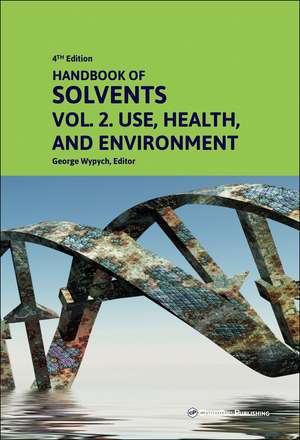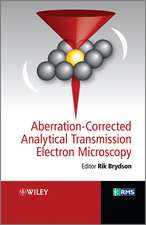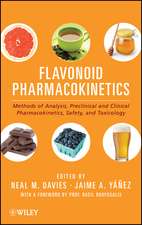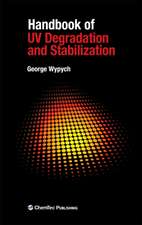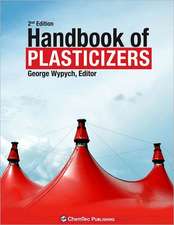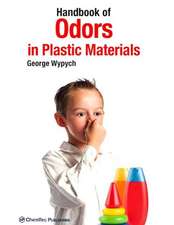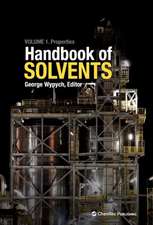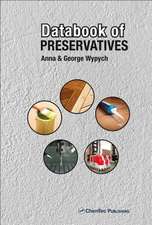Handbook of Solvents, Volume 2: Use, Health, and Environment
Editat de George Wypychen Limba Engleză Hardback – 23 apr 2024
- Assists in solvent selection by providing key information and insight on environmental and safety issues
- Provides essential best practice guidance for human health consideration
- Discusses the latest advances and trends in solvent technology, including modern methods of cleaning contaminated soils, selection of gloves, suits, and respirators
| Toate formatele și edițiile | Preț | Express |
|---|---|---|
| Hardback (3) | 1061.82 lei 5-7 săpt. | |
| ELSEVIER SCIENCE – 22 iul 2014 | 1061.82 lei 5-7 săpt. | |
| ELSEVIER SCIENCE – 13 feb 2019 | 1351.88 lei 5-7 săpt. | |
| ELSEVIER SCIENCE – 23 apr 2024 | 1514.85 lei 5-7 săpt. | +139.59 lei 4-10 zile |
Preț: 1514.85 lei
Preț vechi: 1992.65 lei
-24% Nou
Puncte Express: 2272
Preț estimativ în valută:
289.96€ • 315.07$ • 243.72£
289.96€ • 315.07$ • 243.72£
Carte tipărită la comandă
Livrare economică 14-28 aprilie
Livrare express 14-20 martie pentru 149.58 lei
Preluare comenzi: 021 569.72.76
Specificații
ISBN-13: 9781774670422
ISBN-10: 1774670429
Pagini: 820
Dimensiuni: 152 x 229 x 44 mm
Greutate: 0.45 kg
Ediția:4
Editura: ELSEVIER SCIENCE
ISBN-10: 1774670429
Pagini: 820
Dimensiuni: 152 x 229 x 44 mm
Greutate: 0.45 kg
Ediția:4
Editura: ELSEVIER SCIENCE
Cuprins
1. Solvent Use in Adhesives and Sealants
2. Solvent Use in Aerospace
3. Solvent Use in Asphalt Compounding
4. Solvent Use in Biotechnology
5. Organic Solvents in Microbial Production Processes
6. Solvent Resistant Microorganisms
7. Choice of Solvent for Enzymatic Reaction in Organic Solvent
8. Solvent Use in Coil Coating
9. Solvent Use in Cosmetics and Personal Care Products
10. Solvent Use in Dry Cleaning- Treatment of Textiles in Solvents
11. Solvent Use in the Electronic Industry
12. Solvent Use in Fabricated Metal Products
13. Solvent Use in the Food Industry
14. Solvent Use in Ground Transportation
15. Solvent Use in Inorganic Chemical Industry
16. Solvent Use in Iron and Steel Industry
17. Solvent Use in Lumber and Wood Products
18. Solvent Use in Medical Applications
19. Solvent Use in Metal Casting
20. Solvent Use in Motor Vehicle Assembly
21. Solvent Use Organic Chemical Assembly
22. Solvent Use in Paints and Coatings
23. Architectural Surface Coatings and Solvents
24. Recent Advances in Coalescing Solvents for Waterborne Coatings
25. Solvent Use in the Petroleum Refining Industry
26. Solvent Use in the Pharmaceutical Industry
27. Use of Solvents in the Manufacture of Drug Substances and Drug Products
28. Predicting Cosolvency for Pharmaceutical and Environmental Applications
29. Solvent Use in Polymers and Man-Made Fibers
30. Solvent Use in the Printing Industry
31. Solvent Use in Pulp and Paper
32. Solvent Use in Rubber and Plastics
33. Solvent Use in the Shipbuilding and Ship Repair Industry
34. Solvent Use with Stone, Clay, Glass, and Concrete
35. Solvent Use in the Textile Industry
36. Solvent Use for Transportation Equipment Cleaning
37. Solvent Use in Water Transportation
38. Solvent Use with Wood Furniture
39. Standard Methods of Solvent Analysis
40. Special Methods of Solvent Analysis
41. Simple Test to Determine Toxicity of Bacteria
42. Residual Solvents in Various Products
43. Residual Solvents in Pharmaceutical Substances and Products
44. The Environmental Fate and Movement of Organic Solvents in Water, Soil, and Air
45. Fate-Based Management of Organic Solvent-Containing Wastes
46. Organic Solvent Impacts on Tropospheric Air Pollution
47. Measurement and Estimation of Solvents Emissions and Odor
48. Emission of Organic Solvents During Usage of Ecological Paints
49. Indoor Air Pollution by Solvents Contained in Paints and Varnishes
50. Solvent Uses with Exposure Risks
51. Solvent Regulations in the US and Other Countries
52. Solvent Regulations in Europe
53. Toxicokinetics, Toxicodynamics, and Toxicology
54. Pregnancy Outcome Following Maternal Organic Solvent Exposure
55. Industrial Solvents and Kidney Disease
57. Lymphohematopoietic Study of Workers Exposed to Benzene Including Multiple Myeloma, Lymphoma, and Chronic Lymphatic Leukemia
58. Solvent Use and Chromosomal Aberrations and Sister Chromatoid Exchanges
59. Solvent Use and Hepatoxicity60. Toxicity of Environmental Solvent Exposure for Brain, Lung, and Heart
60. Supercritical Solvents
61. Ionic Liquids
62. Deep Eutectic Solvents and Their Applications as New Green Reaction Media
63. Novel Applications of the Bio-Based Solvent Ethyl Lactate in Chemical Technology
64. Absorptive Solvent Recovery
65. Solvent Recovery
66. Solvent Treatment in a Paints and Coating Plant
67. Application of Solar Photocatalytic Oxidation to VOC-Containing Airstreams
68. Gloves for Solvent Use
69. Suit Materials for Solvent Use
70. Respiratory Protection for Solvent Use
2. Solvent Use in Aerospace
3. Solvent Use in Asphalt Compounding
4. Solvent Use in Biotechnology
5. Organic Solvents in Microbial Production Processes
6. Solvent Resistant Microorganisms
7. Choice of Solvent for Enzymatic Reaction in Organic Solvent
8. Solvent Use in Coil Coating
9. Solvent Use in Cosmetics and Personal Care Products
10. Solvent Use in Dry Cleaning- Treatment of Textiles in Solvents
11. Solvent Use in the Electronic Industry
12. Solvent Use in Fabricated Metal Products
13. Solvent Use in the Food Industry
14. Solvent Use in Ground Transportation
15. Solvent Use in Inorganic Chemical Industry
16. Solvent Use in Iron and Steel Industry
17. Solvent Use in Lumber and Wood Products
18. Solvent Use in Medical Applications
19. Solvent Use in Metal Casting
20. Solvent Use in Motor Vehicle Assembly
21. Solvent Use Organic Chemical Assembly
22. Solvent Use in Paints and Coatings
23. Architectural Surface Coatings and Solvents
24. Recent Advances in Coalescing Solvents for Waterborne Coatings
25. Solvent Use in the Petroleum Refining Industry
26. Solvent Use in the Pharmaceutical Industry
27. Use of Solvents in the Manufacture of Drug Substances and Drug Products
28. Predicting Cosolvency for Pharmaceutical and Environmental Applications
29. Solvent Use in Polymers and Man-Made Fibers
30. Solvent Use in the Printing Industry
31. Solvent Use in Pulp and Paper
32. Solvent Use in Rubber and Plastics
33. Solvent Use in the Shipbuilding and Ship Repair Industry
34. Solvent Use with Stone, Clay, Glass, and Concrete
35. Solvent Use in the Textile Industry
36. Solvent Use for Transportation Equipment Cleaning
37. Solvent Use in Water Transportation
38. Solvent Use with Wood Furniture
39. Standard Methods of Solvent Analysis
40. Special Methods of Solvent Analysis
41. Simple Test to Determine Toxicity of Bacteria
42. Residual Solvents in Various Products
43. Residual Solvents in Pharmaceutical Substances and Products
44. The Environmental Fate and Movement of Organic Solvents in Water, Soil, and Air
45. Fate-Based Management of Organic Solvent-Containing Wastes
46. Organic Solvent Impacts on Tropospheric Air Pollution
47. Measurement and Estimation of Solvents Emissions and Odor
48. Emission of Organic Solvents During Usage of Ecological Paints
49. Indoor Air Pollution by Solvents Contained in Paints and Varnishes
50. Solvent Uses with Exposure Risks
51. Solvent Regulations in the US and Other Countries
52. Solvent Regulations in Europe
53. Toxicokinetics, Toxicodynamics, and Toxicology
54. Pregnancy Outcome Following Maternal Organic Solvent Exposure
55. Industrial Solvents and Kidney Disease
57. Lymphohematopoietic Study of Workers Exposed to Benzene Including Multiple Myeloma, Lymphoma, and Chronic Lymphatic Leukemia
58. Solvent Use and Chromosomal Aberrations and Sister Chromatoid Exchanges
59. Solvent Use and Hepatoxicity60. Toxicity of Environmental Solvent Exposure for Brain, Lung, and Heart
60. Supercritical Solvents
61. Ionic Liquids
62. Deep Eutectic Solvents and Their Applications as New Green Reaction Media
63. Novel Applications of the Bio-Based Solvent Ethyl Lactate in Chemical Technology
64. Absorptive Solvent Recovery
65. Solvent Recovery
66. Solvent Treatment in a Paints and Coating Plant
67. Application of Solar Photocatalytic Oxidation to VOC-Containing Airstreams
68. Gloves for Solvent Use
69. Suit Materials for Solvent Use
70. Respiratory Protection for Solvent Use
